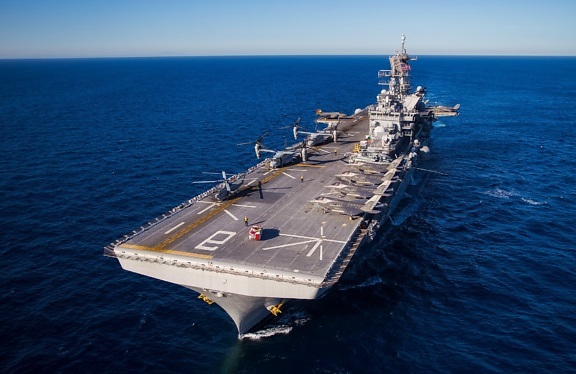
Analysis suggests that China’s indigenous electromagnetic catapult-equipped aircraft carrier, The Fujian, may be poised for its maiden sea trial, as indicated by recent images circulating on Chinese social media. These images depict the 80,000-ton vessel in its final configuration, showcasing completed deck markings including taxi guidelines, parking areas, and take-off and landing indicators. Notably, the presence of four full-scale deck aircraft models draws significant attention, particularly the KJ-600 early warning aircraft prominently positioned on Fujian’s corner deck. Additional aircraft models observed include the J-15 multi-role fighter, the stealthy J-35 fighter, and the Advanced Trainer Aircraft Deck Base 10.
What does this signify? Simply put, it suggests that the deck marking process is nearing completion, a crucial milestone before further installations can proceed. Once the paint dries and the line drawing process is finalized, Fujian will be poised for its inaugural sea trial. Despite being docked at the shipyard, Fujian has already played a pivotal role in crucial mooring tests, indicating its readiness for broader trials.
Preparations for Fujian’s sea trials encompass various critical assessments, including ship illumination, fire control systems, communication infrastructure, ventilation and drainage systems, as well as the integrity of watertight doors, anchors, and engines. Drawing from the experiences of Liaoning and Shandong, China’s first aircraft carriers, Fujian’s readiness for sea trials hinges on the successful completion of forthcoming tests, notably the center of gravity shift test.
Reflecting on past events, let’s revisit April 23 six years ago when the Shandong embarked on a significant milestone by departing its barge-operated dock for a pivotal center of gravity test within the shipyard’s confines. Envision a bustling scene filled with robust engineering vehicles, each mirroring the weight distribution of typical aircraft. Throughout this rigorous examination, these vehicles continually adjusted their positions on the deck, prompting the Shandong to adapt its hull accordingly. With the successful completion of this test, the stage was set for Shandong’s inaugural sea trial merely 20 days later, on May 13. Thus, it’s noteworthy that the center of gravity shift test serves as a fundamental precursor to a vessel’s maiden sea trial.
Turning our attention to the present, the deck of the Fujian aircraft carrier currently lacks the presence of large-scale engineering vehicles. However, there’s a plausible expectation that full-scale models or actual aircraft, simulating deck-based operations, may soon grace the flight deck as part of comprehensive gravity displacement assessments. The identification of aircraft such as the J-15s, J-35s, KJ-600s, and Trainer-10s as models could signify the utilization of internal counterweights to mimic the effects of real deck-based aircraft. In the near future, reports may emerge of Fujian’s relocation from the dock via a barge to undergo gravity shift tests within the shipyard’s port.
As Fujian eventually sets sail from the shipyard for ocean trials, the world will witness the debut of the only non-American “super aircraft carrier,” undoubtedly a momentous occasion for the People’s Liberation Army Navy.




